|
Ampeer Paper Subscriber Reminder
When subscribing to or renewing the paper version of the Ampeer, please make the check payable to Ken Myers. We do not have a DBA for the Ampeer or EFO. Thanks, Ken
Porterfield Collegiate For Sale
Complete except for Speed control and receiver battery.
Includes Astro Flight 25G, 7ch Transmitter & receiver
Covered with Micafilm and finished with dope
Asking $100
Richard Fleming
408 Cottage St.
Olivet, MI 49076
269-749-9024
Upcoming EFLIOWA 08
From Orville Shields osrs73@yahoo.com
HI Ken,
Hope summer weather makes it to your Mid Am event by July. It sure has not arrived here in Iowa yet. We are hoping it makes it for our Electric Fly-In in September.
This year will be number 11. It was started by Jon McVay back in '98. Last year your own eflight guru Keith Shaw came out and gave us a look at some of his impressive machines. He's not bad on the sticks either. Maybe you could make it out our way some time.
I really enjoy your no-nonsense approach to what works and all your years of the information in your newsletter.
We are planning to have a great time and want everyone to know that there is plenty of room at the Sod Farm for more.
The details are September 6 and 7, Davenport RC Society Field, Seven Cities Sod Farm, 12554 210th St, Davenport, Iowa, 52804. $15 landing fee for both days, AMA required.
We will have a raffle for pilots and a lunch is available. Questions to Orville Shields, osrs73@yahoo.com, 309-236-6167.
Thanks,
Orville
Return to "What's In This Issue"
More A123 Successes
From Ed Summers sumsslm@comcast.net

Ken:
I cannot express my appreciation for the effort you put forward in the support of the Electric group of Model Airplane enthusiast. Probably because of your efforts and the discouraging results of Li-Poly cells, (cost vs life) all of the larger models my son Kimball and I now fly are using the A123 cells. I included a picture of Kimball with our ERATIX 3D ARF. Santa gave us two of these for Christmas and even though we have only assembled one of these, the results are very impressive. (The ARF is available from E-flite). Power is from a 5 cell A123, Jeti opto 70 speed control, 700ma flight battery (AAA), Hitec 225 MG/BB servos (4) and an AXI 2826-12 with a 13x6.5 APC prop. We get 8-minute flights of full acrobatic fun. I have made 7 packs so far, and we don't need to take a charger to the field except for the flight battery. Fortunately we have AC power at our field.
I have been flying an Accord 47 on 3 cells with an AXI 2820-10, and I have made 6 cell packs for a friend who is flying a Hanger 9 Piper Pawnee ARF and 5 cell packs for his Beaver. We have had great success with the A123s. We've brought the 5 cells down to the point where they register 4 cells on the AF109 123 chargers, and by putting them on the AF112 to bring the voltage up to 16+/- volts, then go to the AF109 to finish the charge.
We do use the Blinky on each and every charge and find our cells are all very close in voltage.
I hope I am not the reason the price of A123s has risen on Ebay.
Keep up your great work. It is greatly appreciated.
Ed & Kimball Summers, Salem, OR
Return to "What's In This Issue"
The Keith Shaw Birthday Party Fly-in
Dave Grife and the Balsa Butcher's hosted another great e-fly in. When Chris and I arrived at the flying site some folks were already in the air. We had worried about rain. Even though the day started out with a gray, overcast sky, it actually turned out to be a very nice flying day, although a tad on the windy side. The wind did not dampen the amount of flying. There were always several planes in the air at all times.
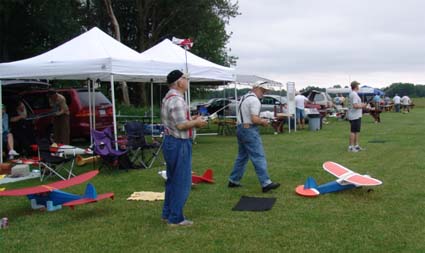
Plenny and Bob came over from Iowa with there fleet of old timers, the planes not them!
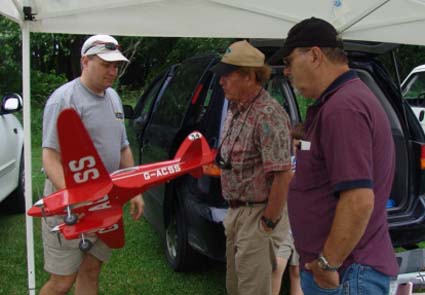
Jim Young had his Comet design freshly equipped with Robart retracts.
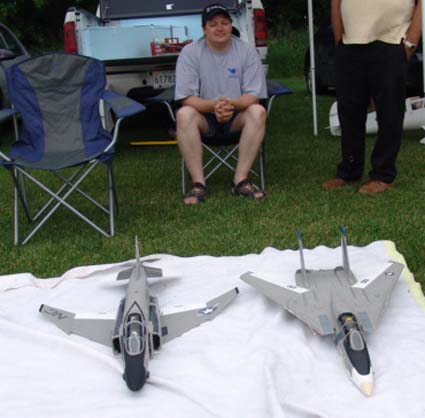
Mark Wolf had two outstanding looking "foam" jets. They are equipped with pusher motors, and have to be seen to be believed. They are gorgeous!

Dick Fleming had a new DO 217 that flew very nicely. The birthday boy, sitting in the background here, got a chance to give it a go.
Unfortunately, Sunday had extremely high winds, and only a very few people got planes into the air. Even with Sunday being "winded out", it was still an extremely enjoyable weekend.
Thanks Dave and the Balsa Butchers for another great time!
Return to "What's In This Issue"
The June 21 EFO Flying Meeting
The weather was perfect for the Saturday "flying meeting." Many EFO members had out some new planes, and had a lot of fun sharing their latest creations.
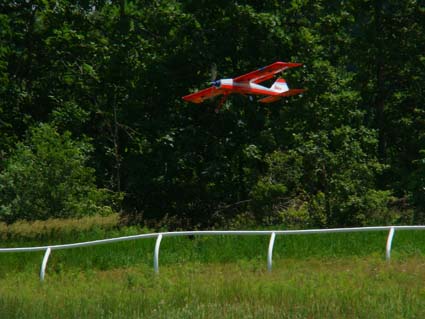
Roger Wilfong's MUS flew well and so did his "Ugly Stik"
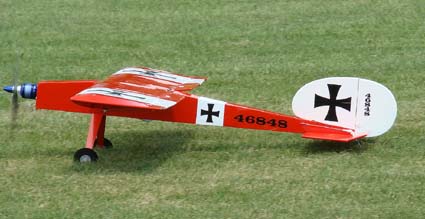
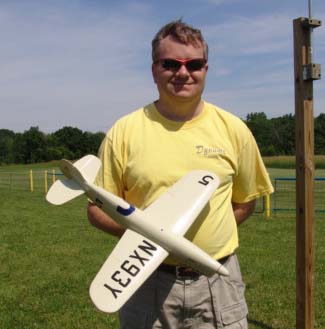
Jim Young's Goon gave us the most thrilling flight of the day. This little guy is FAST and was a handful to tame in the air. Nice flying Jim!
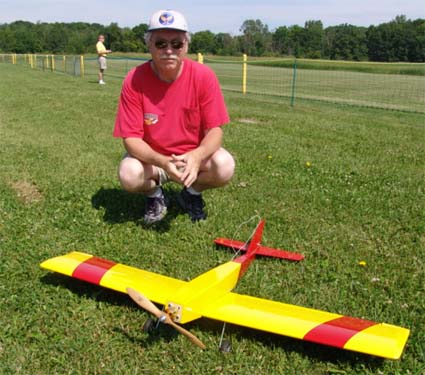
Richard flew his new AXI powered Q500 ARC from Hobby People. Love the color scheme. ;-)
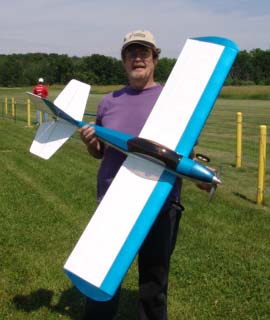
EFO member Jim, flew his new Mountain Models Senior Switchback. This is a very nice flying plane that doesn't take gobs of power to perform very well. Thanks Jim for some of the photos shown here.
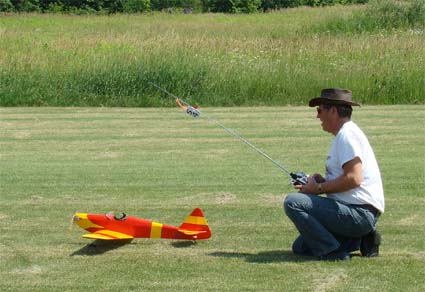
Ken flew the Son of Swallow with the K2 Energy pack in it. He has updated the information about these "other" lithium iron phosphate cells on his K2 site at www.theampeer.org/K2/K2.htm
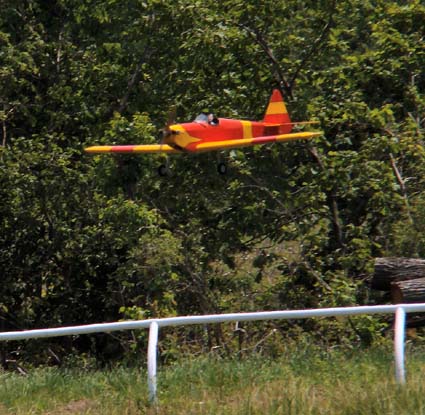
It was a great day of flying, sharing and just enjoying a beautiful Michigan summer day.
Return to "What's In This Issue"
Understanding a Battery's C-rate and It's Relationship to Time
By Ken Myers
A secondary cell's capacity is described by its C-rate, also known as C or capacity. The manufacturer uses a battery analyzer to test the cell at a specific ambient temperature for one hour to determine its C-rate. During the hour time period, the cell's voltage will go from a fully charged state to a specified minimum voltage. The resulting number is its C-rate, which is expressed in amps per hour or Ah.
When cells of the same type are hooked together in series, the resulting battery has the same capacity as the individual cells. As identical cells are attached in series, the voltage of the resulting battery goes up, but the capacity remains the same.
The 26650 M1 cell from A123 Systems, Inc. is rated at 2.3Ah. That means that the manufacturer claims that the cell can deliver 2.3 amps for one hour from a fully charged state to a fully discharged state.
Usually the cell/battery we use in our hobby is marketed with the milliamp hour capacity noted. The milliamp is 1/1000 (0.001) of an amp. A 2.3Ah cell, when rated in milliamps per hour (mAh), would be 2.3Ah times 1000 or 2300mAh.
A large majority of the power systems used in our electrically powered models "pull" amps, not milliamps, so it is always best to "think" in Ah when working with the C-rate for power systems, not mAh.
If a cell/battery capacity is listed as mAh, divide it by 1000 to "think" in Ah terms. For example, if a cell/battery is rated at 700mAh, think 0.7Ah, which is 700mAh divided by 1000.
Both the manufacturer's charge and discharge current of a battery are measured in relationship to the C-rate or C.
If a 0.7Ah cell/battery is charged or discharged at a 1C rate it is being charged at 0.7Ah / 1h. The h (hours) in the equation cancel each other out mathematically, so the formula becomes 0.7A / 1 = 0.7A (amps). That is the 1C charge/discharge rate. Since 1 times anything is still the "anything", it is common practice to not write the 1, thus just the letter C is noted.
The same math applies to a 2.3Ah cell/battery when it is charged or discharged at a 1C-rate. It is being charged at 2.3Ah / 1h. Again, the h (hours) cancel each other out mathematically, so the formula becomes 2.3A / 1 = 2.3 A (amps). That is the C charge/discharge rate.
It has been the typical practice to charge the NiCad and NiMH type batteries, used to supply power to the transmitter or receiver of our radio systems, at a C/10 rate. C/10 should be thought of as the cell/battery C-rate divided by 10 hours (h). For the 0.7Ah cell/battery the formula would be 0.7Ah / 10h. The hours cancel each other out and the formula becomes 0.7 A (amps) / 10 = 0.07 amps. This is now a case where milliamps are usually used. 0.07 amps times 1000 = 70 milliamps.
In the theoretical world, a 70-milliamp charger would completely charge a totally discharged 0.7Ah cell/battery in 10 hours. In the real world it takes longer due to inefficiencies, and we tend to call this "an overnight charge" and usually charge for 12 to 14 hours, as the slight overcharge at the low 70-milliamp rate doesn't seem to harm the NiCad or NiMH cell/battery.
When a battery is used to power electric motors for flight, a C/10 or even a C charge rate (1 hour) is not too practical at the field and a C discharge rate is impractical for good performance in most power applications.
The manufactures of cells recommend a maximum charge and discharge rate for a given number of cell/battery cycles. The number is based on the C-rate.
If the manufacturer says a cell can be charged at twice the C-rate it is said to have a 2C charge rate. Using the 0.7Ah cell as an example, that means that the cell can be charged at 2 times (0.7Ah / 1h) or 2 times 0.7 amps, which equals 1.4 amps. Since the cell/battery is being charged at twice the C-rate the time required to charge the battery is cut in half so that only 1/2 an hour is required. Also, if a fully charged 0.7 Ah cell is loaded to 1.4 amps, it will take 1/2 an hour to be completely discharged. Therefore, 2C always equals 1/2 an hour or 30 minutes.
Many early Lithium Polymer batteries were limited to a 1C charge rate (1 hour) and 3C discharge rate. If the 0.7Ah battery was one of these it would charge in an hour and discharge in 1/3 of and hour (20 minutes) when the current was 3 times 0.7 which equals 2.1 amps. 3C is always 20 minutes.
There were not usually any specifications given by a NiCad cell's manufacturer as to maximum charge or discharge rates. All of their specifications related to much lower power applications, although some suppliers took it upon themselves to supply some suggested numbers.
It was not unusual to use a good NiCad, like the Sanyo "R" series, at a discharge rate of between 15C and 20C when powering our electric motors. (Many folks went much higher than that for specialized applications.) Therefore a "good" 0.7Ah cell could be used in an application that had a maximum amp draw of between 10.5 amps (15 times 0.7) and 14 amps (20 * 0.7). The time to charge or discharge at 15C is 1/15 or an hour or 4 minutes and 20C is 1/20 of an hour or 3 minutes. Of course these were NOT flight times, as the average amp draw would have been considerably less than the maximum amp draw.
It was also "common practice" to charge "good" NiCads at 3C to 4C. I've already demonstrated that 3C is twenty minutes and 4C would be 1h / 4 = 1/4h or 15 minutes. The 3C charge rate for the 0.7Ah cell/battery was previously noted as 2.1 amps, while the 4C rate would be 4 times 0.7A or 2.8 amps.
When NiMH first appeared they were somewhat of a step backwards in powering electric motors. They typically could not be charged at a higher rate than C, so they took an hour to charge and they could not be discharged at more than about 10C without shortening their life cycles a lot.
They did have did have some advantages though. They weighed less for the same capacity rating and the maximum 10C amp draw meant that it took 1hr / 10 which is 1/10 hour (6 minutes) to fully discharge and the flight times increase proportionally.
A 10C amp draw for a 0.7Ah NiMH would be 7 amps.
Okay, What's the Bottom Line?
No matter what the stated capacity is, the C-rate time is always 1 hour (60 minutes) divided by the number before the C.
C is always understood to mean 1C. It always applies equally to both the charge and discharge.
The following shows the relationship to C and time.
C (1C) = 1 hour (60 minutes)
2C = 1/2 hour (30 minutes)
3C = 1/3 hour (20 minutes)
4C = 1/4 hour (15 minutes)
5C = 1/5 hour (12 minutes)
6C = 1/6 hour (10 minutes)
10C = 1/10 hour (6 minutes)
15C = 1/15 hour (4 minutes)
25C = 1/25 hour (2.4 minutes or 2 min. 24 sec.)
30C = 1/30 hour (2 minutes)
The maximum specified amps for both the charge and discharge is always the number before the Ah in the capacity rating times the number before the C-rate. A 0.340Ah (340mAh) cell with a maximum discharge rate of 10C would have a maximum amp draw of 3.4 amps. A 3.4Ah cell with a 10C maximum discharge rate would have a 34 amp maximum amp draw. 10C is 6 minutes. If run at their maximum recommended 10C amp draws, both cells would be depleted in 6 minutes.
Recommended Maximum C-rates for both the charge and discharge of a cell/battery are helpful, and gave a hint as to how a cell/battery can be used and still maintain a useful number of life cycles.
If you time your flights for a non-glider type aircraft, you can also find the average C rating for your aircraft and power system combination.
My Son of Swallow flies for 6 minutes using either a 3S A123 Systems 2.3Ah battery or a 3S K2 Energy 2.5Ah battery. 6 minutes is 10C. That means that the average amp-draw for the A123 pack is 10 times 2.3 or 23 amps and for the K2 pack it is 10 times 2.5Ah or 25 amps. The numbers show that I'm well within the maximum recommended for the A123 cell, which is 30C (69 amps) and for the K2 cell that is 16.8C (42 amps).
Return to "What's In This Issue"
The Node/Balance Connector Gotcha with the FMAdirect CellPro 10S
By Ken Myers
Because Keith could not stop "talking up" how great the FMAdirect CellPro 10S charger is, and because Bob Aberle was also so impressed with it (www.masportaviator.com/ah.asp?CatID=7&ID=202), I decided to purchase one. I had also read a recent positive review of it on the Ezone/RC Groups site, www.rcgroups.com/forums/showthread.php?t=780132.
I have four Li-Po batteries; 2 Skyshark 4S 4000mAh, 1 Skyshark 3S 2100mAh and a True RC 5S 4000mAh. I also have three A123 Systems, Inc. 26650 2300mAh LiFePo4 batteries; two 6S and a 3S. I have a 3S K2 Energy LiFePo4 26650 2500mAh pack. All of their node/balance connectors came wired the same with a similar connector with 0.1 (1/10) inch pin spacing (pitch) or I used a similar connector wired the same way so that I could use my appropriate Astro Flight Blinkies and my CellMeter-8 with them. My node/balance connectors are all wired from most negative to positive with no skipped pins. That means that the 3S packs use a 4 pin connector, the 4s packs use a 5 pin connector, the 5S pack uses a 6 pin connector and the 6S packs use a 7 pin connector. As I mentioned before, the connectors have a 0.10-inch pin spacing, as used for the AF Blinkies. All was "right with my world", but... I mistakenly thought the connectors were the same and wired the same as on the "PolyQuest" type packs.
When I ordered my CellPro 10S I also ordered the FMAdirect USB Interface Module for 2 way data communication with my wife's Windows computer and the Cellpro 10s Charger to Thunder Power or PolyQuest Adapter (CP10S-TP/PQ6S). To my chagrin, I found that my 3S packs could not use this adapter! Why? My Skyshark 3S Li-Po and my 3S A123 and K2 pack are wired with a 4-pin node/balance connector with no skipped pins! "PolyQuest/Enerland" use a 5-pin node balance connector on 2S, 3S and 4S packs. This means that there are "unused pins" in the 2S and 3S node/balance connector because they are using a 5-pin node/balance connector.
I had to reorder the correct adapter, partly my fault and partly FMAdirect's fault. It was my fault because I had misunderstood what type of balance system I was using. Since it worked with my Blinkies, and since "PolyQuest" seemed to me to be a "standard" with 0.10 pin spacing (I was wrong), that's what I thought I was using. Since Skyshark was not listed on the FMAdirect Web site in the compatible batteries list, I believe that FMAdirect should make it clearer as to the pin spacing and number of pins the node/balance connector uses, and the wiring of the node/balance connector.
Instead of just listing "all" of the batteries the adapter works with, there should be an illustration and/or annotation to help the user decide which adapter is appropriate.
Here is an example of what I mean.
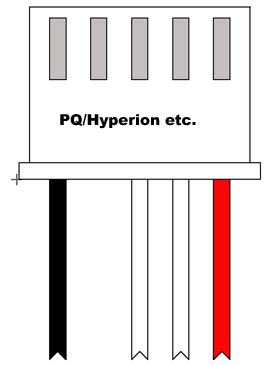
The above connector is typical of Enerland (formerly PolyQuest), Hyperion, Impulse, and Apache 3S packs. The most negative lead is on the left when viewed so that the pin holes are visible, with the most positive on the right with a skipped pin next to the negative lead. The 2S packs of these bands have two skipped pins next to the negative lead. The connector has a 2.5mm / 0.10 in. pitch. The 2S and 3S packs cannot be used with the AstroFlight Inc.TM Blinky without an adapter.
The following connector is typical of the Great Planes ElectriFly "Power Series", Horizon E-flite, Horizon ParkZone, DualSky Xpower, Esky, Align, Dynam, 3E, BatteryHobby, X-Caliber, RadicalRC, CommonSense RC (v2), DN Power, HiModel, HexTronik, Mega Power, Hobby City, Zippy-R, and Skyshark* 3S packs. (I added the Skyshark.) The most negative lead is on the left, with the most positive on the right and there are no skipped pins. The 2S packs of these brands use a 3-pin connector, wired in a similar fashion from most negative to most positive. The connector has a 2.5mm / 0.10 in. pitch. All of these packs can be used with the AstroFlight Inc.TM Blinky without an adapter.

I hope that I have made it clear as to why I became confused about the adapter that I needed, and why FMAdirect needs to update their information so that others do not make the same mistake.
What bothered me most about all of this was that the complete first shipment, including the charger, USB cable and "PolyQuest" adapter, was sent for $8.95 and they charged $8.95 to send just the two CP10S-GP/KO6S adapters. (This was NOT TRUE. After checking my actual receipt I found the shipping to be a reasonable $3.00. Sorry for the confusion but the orginal billing indicated $8.50. KM 07/24/08) My node/balance connector frustration was exacerbated by the slow delivery of the correct adapters. The adapters were ordered on Sunday, July 6 and didn't arrive until Friday, July 11. While this is not "horrible" service, I had also ordered a prop adapter from AllERC on the same day, and it arrived on Wednesday, July 9. Both items were shipped via the US Postal service.
Another problem arose when I tried following the directions from the online instruction manual for "Connecting the charger to your computer". If the directions are followed as printed, nothing happens when the software is running. The charger must first be connected to a 12v source and then the directions followed.
Still another problem arose in the section on "Defining presets". The instructions say, "Each preset consists of a name, a chemistry and a charge current." I believe that this is INCOMPLETE and should say, "Each preset consists of a name, a chemistry selection, a charge current and number of packs." The instructions do note later on that when using a 6S to 10S pack the Single Pack option should be checked, but I missed that, even though I read through the manual several times before actually using the charger.
There are several things that I don't care for when using the Cellpro 10s Charge Control Software or that I feel should be, or could be, improved.
I feel that the program should open to a radio button selection box where the user is given the choice of 'Start a New Session', which would be the default and open the file name window and the alternate choice being 'Review Previous Data' that would open the open file window. I've forgotten to give the file a name before starting the charger several times.
The graph feature turns out to be only "eye candy" as no useful data points can actually be read on the graphs, but trends can be seen. Unfortunately, when a previous session file is retrieved into the software, only the graph data is available. The data originally shown in the 'Cells' tab of the main window and the 'Int.Res' tab is NOT recovered or displayed.
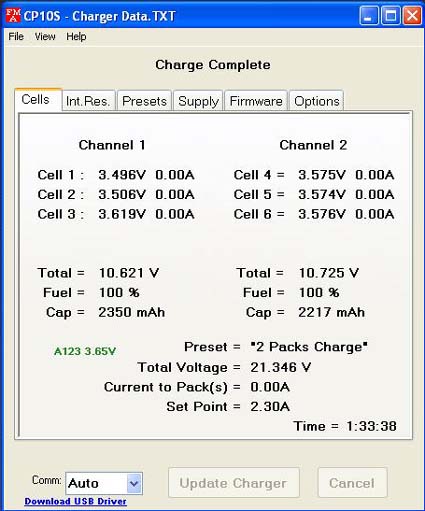
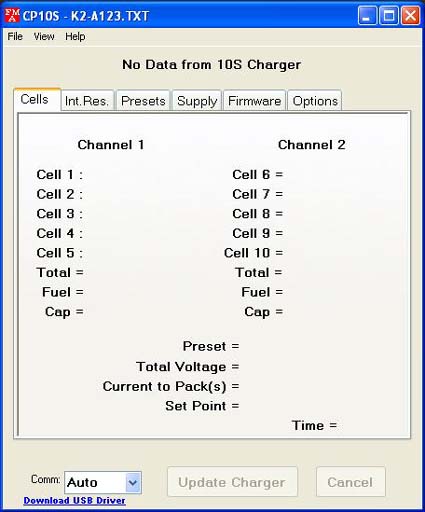
Completed data on top, retrieved data on bottom
Both are from the same charge.
I manually renamed the file.
All is not lost though. If you want to review all the charge data for a given battery. In the section of the manual 'Recording charge data' it says, "Charge data is stored in a semicolon-delimited format, which can be imported into a spreadsheet for analysis."
I used the FREE Open Office "Calc" spreadsheet program to open the battery .TXT file on the Windows machine and Microsoft Excel on my Mac. Using a spreadsheet to review all of the saved data in the battery .TXT file is an excellent feature! The data is ALL there to be analyzed.
Finally, A Chance to Put the Charger to Work
I have been beta testing the K2 Energy 26650 2500mAh LiFePO4 cells and wanted to get a direct comparison of the internal resistance to the A123 26650 2300mAh LiFePO4 cells I had been using. I knew that it was higher for the K2 Energy cells because of the pack's higher measured heat after charging and flying, but I wanted to know by how much. The FMAdirect CellPro 10S answered that question!
I ran three charge cycles at the same time on the two 3S batteries, one at 2.3 amps, one at 5.0 amps and one at 7.5 amps, using the 3.65v A123 default on the charger at the time I tested. By checking the saved .TXT files via the spreadsheet method I confirmed that the K2 Energy cells had a lot higher internal resistance, when compared to the A123 cells.

The spreadsheet shows that the IR for the K2 cells is more than three times greater than the A123 cells when charged at the same rate at the same time. This clearly confirms why the K2 pack gets "hotter" during charge and discharge, and why it is "harder" to get energy out of the pack. It also explains the greater voltage depression of the K2 pack under load. This is a very nice feature of the CellPro 10S.
I was somewhat disappointed to find that the terminal voltage for the A123 cells could not be changed but FMAdirect has updated the firmware to 3.800v now. At first, FMAdirect elected to use 3.65v as the terminal voltage for the lithium iron phosphate cells. Keith's and my usage and testing of the A123s has indicated that 3.80v to 3.85v "might" be a better choice. I used a temporary workaround. After the third cycle test with the K2 pack and A123 pack at 7.5 amps, I set the charger to the Li-Po STORE mode, as that is set to 3.85v for the terminal voltage, and topped the A123 pack by itself. If an A123 pack is taken to the previous default 3.65v terminal voltage, then the resting open voltage drops to between 3.45v and 3.5v per cell in about 24 hours. 48 hours after the A123 pack was topped to the STORE voltage of 3.85v on the 10S, the CellMeter-8 read the cell voltages as; 3.687v, 3.678v, 3.678v, which is where "I believe" they should be.
Things I Like About My New CellPro 10S
1.) It is the highest wattage charger I have and gives the fastest charges.
2.) It is very easy to use.
3.) It is the "safest" charger that I've used for Li-Po cells.
4.) It has a mode for A123 type cells.
5.) The excellent data that can be retrieved via a spreadsheet.
6.) FMAdirect raised the termination voltage of A123 cells to 3.80v.
Things I Don't Care for About My New CellPro 10S
1.) The node/balance connector "Gotcha".
2.) Having to open a spreadsheet to retrieve the data that was displayed by the software until the charger was disconnected.
3.) FMAdirect's one price shipping policy Not true, see statement above regarding the shipping price of the 2 adapters. Consider this deleted as of 07/24/08 KM
4.) The fact that FMAdirect decided that they had to add one more connector to the mix and reverse the wiring polarity.
5.) No direct charging though the "discharge leads" without hooking up the node/balance connectors because the A123 chemistry cells donŐt need balancing every charge.
6.) No discharge capability. I didn't think this was a "biggie" until I had to discharge the packs I was "testing" on my AF 109 before I could recharge them again on the CellPro 10S.
Return to "What's In This Issue"
Keith Shaw's New Crosby CR-4 Racer
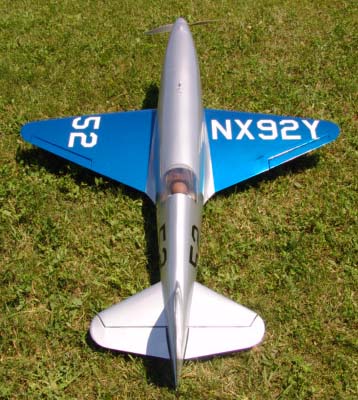
Keith flew the maiden on July 6 and did a second flight, after some tweaking using what he learned from the maiden on July 14. The second flight was very good, and demonstrated the potential of this plane. Here is the story about the plane and maiden flight in Keith's own words after the July 6 flight. KM
The weather and work finally cooperated to let me get a short test hop on the Crosby. There are several things I need to change before the next try and I don't know if I will have time to do them before Mid-Am.
First the good news. I have plenty of power, even at a reduced setting I would estimate speed at well over 80 mph, the one full power pass easily toped 100. It has amazingly gentle stall, considering that at 1/4 scale the span is 48", root 20", tip 5", and the airfoil changes from a 14% at the root to about 4% at the tip, and the fuselage is 65" long! The flaps work quite well and at half-flaps the landing slope was very controllable with little pitch change. I did not get a chance to try full flaps, but right now I don't think that will be needed. The roll rate is adequate with those tiny ailerons, and positive all the way to touchdown.
Now for the bad/ugly news. The huge long fuselage seems to be part of the stability function, so that even though it was balanced at 25% MAC, it was slightly tail heavy, and got worse as speed built up. I will have to add some lead to the nose as I have the 8 A123s sitting as far forward as I can get them. The biggest problem is the OUTRAGEOUS P-factor coming from that ridiculously long nose. I had to hold full right rudder through a VERY scary takeoff, and watched as it did a big flat left hand turn with me holding full right rudder and half right aileron. It ungracefully augured its way to about 100' of altitude in a huge 180-turn. Things got a little better when I got the gear up. Once I did a little more trimming, I found that the plane tracked straight in the glide, but as soon as I touched the throttle, I need half right rudder to even hope to get it to fly straight. I made an error by putting in a bunch of right rudder trim that would later come back to haunt me on landing.
Three minutes into the flight I reduced power and lowered the flaps to half. This initially caused a slight pitch up, but as soon as I lowered the gear I got a good controlled descent.
The landing approach looked good except the plane was crabbing at about a 20 degree yaw. Remember the right rudder trim? So while I was jockeying holding left rudder to compensate, and realizing it would not be wise to touch the power, the Crosby touched down in a pretty heavy crab and flipped. The only damage was to the top of the rudder, and my ego/pride. I should have known better.
I will have to re-engineer the nose for some right thrust, I am guessing three degrees at least. The thrust offset would be easy on an uncowled sport plane, but I will have to remake the mount so that the offset will be compensated for the spinner to line up correctly.
I will start the repair and modifications tonight.
But for all the bizarre quirks/ulcers, it REALLY looks cool in the air, like a dart with vestigial wings.
Keith
Determined to build and fly all those "it can't be done" projects
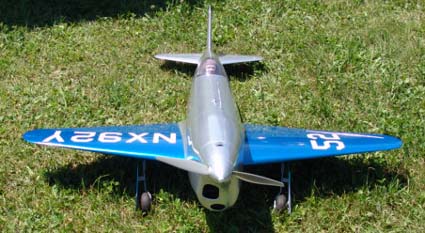 Return to "What's In This Issue"
Return to "What's In This Issue"
|


















